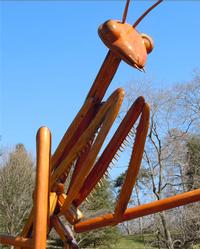
This summer, Tyler Arboretum invites guests to get outdoors and encounter the insect world in a new and surprising way with the exhibit: David Rogers’ BIG BUGS. Dotted along the 1.5 miles of the Arboretum’s Scenic Loop, David Rogers’ BIG BUGS will amaze and delight visitors of all ages as it highlights the outsized role played by these tiny inhabitants of the natural world. Featuring enormous garden sculptures made entirely from natural materials by the Long Island artist David Rogers, BIG BUGS introduces visitors to 17-ft. long dragonfly, 4-ft. wide spider in a 15-ft. web, and invites you to picnics with 25 feet long ants! The exhibit includes ten larger-than-life, anatomically accurate sculptures, accompanied by Education Stations designed to teach and inspire. The following BIG BUGS will be installed among the flower-rich meadows and horticultural collections along Tyler’s paved, 1.5-mile Scenic Loop:
Throughout the summer, docent-led tours and bug-themed special events add to the fun:
A full schedule of educational programs and camp weeks for all ages is available at tylerarboretum.org.
Discover Tyler with David Rogers’ BIG BUGS!
BIG BUGS lure inquisitive guests out onto the Scenic Loop, Tyler’s 1.5 mile long, gently-meandering wald through Tyler’s meadows, and connecting to 17 miles of trails. Starting next to Tyler’s historic Bank Barn, the Scenic Loop winds past the historic Painter Trees to two of the Arboretum’s most appealing tree houses. Children can’t resist the treetop perspective from Fort Tyler and The Tulip Tree House! Passing meadows filled with summer flowers and birds, visitors reach Tyler’s hallmark Giant Sequioa and a paddock with 10 grazing goats – our charismatic, 4-legged meadow managers (mid-May – through mid-September). The Scenic Loop skirts the Arboretum’s Wister Rhododendron Garden, before culminating at Tyler’s Pond, where, on warmer days, turtles sun themselves on semi-submerged logs. Visitors will find ten BIG BUGS at several stops along the gently level grade of the Scenic Loop. Bring your friends and family and explore the Arboretum on your own bug safari as you track down these oversized inhabitants of the insect and arachnid world.
As visitors explore they’ll discover a wealth of FUN BIG BUGS FACTS, including:
OTHER FUN FACTS ABOUT BUGS
Bugs Produce Electricity
Researchers at Case Western Reserve University found that an insect's internal chemicals can be converted to electricity, potentially providing power for sensors, recording devices, and controlling of the bug. The power supply, while small, doesn't rely on movement, light or batteries, just normal feeding.
Insects are miniature chemical refineries, producing chemicals that help with their defense, food processing, and grooming.
Assassin Bugs Poison their Prey
Assassin bugs are predatory insects that are of great benefit to gardeners. They are proficient at capturing and feeding on a wide variety of prey including other bugs, bees, flies, and caterpillars. Prey are captured with a quick stab of the assassin bug’s long mouthparts. After being immobilized by a paralyzing toxin, the prey’s body fluids are then drawn through the assassin bug’s soda straw-like mouthparts.
Ants are Engineers
An ant can lift 20 times its own body weight. If a second grader was as strong as an ant, she would be able to pick up a car. Ants are the world’s most significant earthmovers, moving an estimated 50 tons of soil per square mile, per year. The largest ant colony ever found is over 3,750 miles wide.
Ants are miniature refineries:
Many ants produce formic acid, the same irritant compound found in stinging nettles. A major use of formic acid is as a preservative and antibacterial agent for silage and (other) animal feeds.
Beekeepers use formic acid as a miticide against the tracheal mite (Acarapis woodi) and the Varroa mite. Formic acid is also being investigated for use in fuel cells.
Fire ants sting using a painful and potentially dangerous compound called Solenopsin (C17H35N). Solenopsin is an alkaloid that is toxic to most other ants. It’s also been shown to have cytotoxic, hemolytic, necrotic, insecticidal, antibacterial, antifungal, and anti-HIV properties.
Ants are Equal Opportunity
All workers, soldiers, and queen ants are female.
Ants are Tasty
In many parts of the world, ants are eaten by humans as a delicacy. The pupae of some species of ants are the basis for the Mexican dish called escamoles. They are considered a form of insect caviar and can sell for as much as $40/lb In areas of India. Throughout Burma and Thailand, green weaver ants are used as a condiment with curry and as an addition to a salad called 'yum'. The indigenous people of North Queensland, Australia enjoy ants that are mashed up in water to make a pleasant acidic drink similar to lemon squash. In Mexico and Australia, special honey pot ants are harvested for their sweet, nutritional juices.
Praying Mantids Eat Their Prey Headfirst
Praying mantids are carnivores that eat insects and other small animals, such as crickets, grasshoppers, frogs, lizards, and even small birds. Praying mantids have long necks topped by a triangular head. They can turn their heads 180 degrees—an entire half circle. They're well-camouflaged, adapting colors that help them blend with plants. Some also have amazing body shapes that make them look like leaves or branches. A praying mantid’s front legs have rows of sharp spines to help them hold on to their prey, which they usually begin to eat head first.
Grasshoppers Leap Tall Buildings With a Single Bound
When threatened grasshoppers will often spit a brown, gooey pellet to discourage a prowling field mouse or a hungry bird just long enough to make their escape. A grasshopper’s best defense is to escape by means of giant leaps. If a 6 ft. tall man could jump like a grasshopper, he could spring up 60 feet and cover 120 feet of distance in a single leap.
Dragonflies Are From the Time of the Dinosaurs
Dragonflies were among the first winged insects to evolve over 300 million years ago. Their two sets of wings work independently, allowing dragonflies to maneuver through the air effortlessly. Their huge eyes give them incredible vision in almost every direction except directly behind them.
As adults, dragonflies eat other insects and can consume hundreds of mosquitoes a day. Dragonflies are usually found around lakes, ponds, streams, and wetlands because their larvae (known as nymphs), are aquatic. Adult dragonflies do not bite or sting, but nymphs can deliver a painful though harmless bite.
Spider Silk Could Stop an Airplane in Flight
A spider’s silk helps it ensnare its insect prey, cocoon its eggs, and helps it to travel on the wind on a parachute thread.
The silk that comes out of the spider’s spinneret is liquid, but it hardens as soon as it comes in contact with air. Spider web silk is five times stronger than a strand of steel of the same thickness. A web made of spider silk as thick as a pencil could stop a Boeing 747 jumbo jet in flight. Scientists still cannot replicate the strength and elasticity of a spider’s silk.
About the Exhibition and the Artist
Since its inception in 1994, David Rogers’ Big Bugs has toured public and private botanical gardens and nature centers throughout the United States, reaching 40 states. The exhibition has educated the public about the importance of preservation and conservation and has helped botanical gardens and nature centers build new audiences, drive membership, and increase visitation.
Born in 1960, David Rogers is originally from Long Island, NY. He began welding scrap metal at the age of 13, before discovering found, natural materials in the mid-1980s. David has been building animals and insects with natural materials since the fall of 1990. Over the years David has worked as an apprentice wooden sailboat builder, a cabinetmaker, and as a carpenter on historic Victorian homes on Long Island’s Gold Coast. He’s also spent time as a cabdriver, a magician’s assistant, a Shakespearean actor, and a sailboat-delivery crew member on the eastern seaboard.
About Tyler Arboretum
Tyler Arboretum is a non-profit public garden just outside the town of Media in Delaware County, PA, serving the Greater Philadelphia region. One of the oldest arboreta in the northeastern United States, Tyler Arboretum features 650 acres of renowned plant collections, heritage and champion trees, and historic buildings, and 17 miles of hiking trails through woodlands, wetlands, and meadows. The Arboretum is an important community resource and cultural destination that’s open to the public year round. Visit: tylerarboretum.org, or call 610-566-9134 to learn more.
Tyler Arboretum Hours of operation:
Monday, Wednesday, Thursday, Friday 9 am – 5 pm
Tuesday 9 am – 8 pm (June 20 – August 29)
Weekends 9 am – 6 pm

POSTS
Souderton Business Improvement District Five Dollar Giveback ProgramARCHIVE
April 2020© BucksCountyAlive.com - Mikula Web Solutions. All rights reserved.
Redistribution of coupons in printed or electronic form is prohibited.